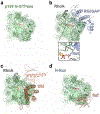The N-Terminal GTPase Domain of p190RhoGAP Proteins Is a PseudoGTPase
- PMID: 30174148
- PMCID: PMC6249675
- DOI: 10.1016/j.str.2018.07.015
The N-Terminal GTPase Domain of p190RhoGAP Proteins Is a PseudoGTPase
Abstract
The pseudoGTPases are a rapidly growing and important group of pseudoenzymes. p190RhoGAP proteins are critical regulators of Rho signaling and contain two previously identified pseudoGTPase domains. Here we report that p190RhoGAP proteins contain a third pseudoGTPase domain, termed N-GTPase. We find that GTP constitutively purifies with the N-GTPase domain, and a 2.8-Å crystal structure of p190RhoGAP-A co-purified with GTP reveals an unusual GTP-Mg2+ binding pocket. Six inserts in N-GTPase indicate perturbed catalytic activity and inability to bind to canonical GTPase activating proteins, guanine nucleotide exchange factors, and effector proteins. Biochemical analysis shows that N-GTPase does not detectably hydrolyze GTP, and exchanges nucleotide only under harsh Mg2+ chelation. Furthermore, mutational analysis shows that GTP and Mg2+ binding stabilizes the domain. Therefore, our results support that N-GTPase is a nucleotide binding, non-hydrolyzing, pseudoGTPase domain that may act as a protein-protein interaction domain. Thus, unique among known proteins, p190RhoGAPs contain three pseudoGTPase domains.
Keywords: ARHGAP35; ARHGAP5; PseudoGTPase; Rho signaling; crystal structure; pseudoenzyme.
Copyright © 2018 Elsevier Ltd. All rights reserved.
Figures






References
-
- Adams PD, Afonine PV, Bunkoczi G, Chen VB, Davis IW, Echols N, Headd JJ, Hung LW, Kapral GJ, Grosse-Kunstleve RW, et al. (2010). PHENIX: a comprehensive Python-based system for macromolecular structure solution. Acta crystallographica Section D, Biological crystallography 66, 213–221. - PMC - PubMed
-
- Ahmadian MR, Stege P, Scheffzek K, and Wittinghofer A (1997). Confirmation of the arginine-finger hypothesis for the GAP-stimulated GTP-hydrolysis reaction of Ras. Nat Struct Biol 4, 686–689. - PubMed
-
- Amin E, Jaiswal M, Derewenda U, Reis K, Nouri K, Koessmeier KT, Aspenstrom P, Somlyo AV, Dvorsky R, and Ahmadian MR (2016). Deciphering the Molecular and Functional Basis of RHOGAP Family Proteins: A SYSTEMATIC APPROACH TOWARD SELECTIVE INACTIVATION OF RHO FAMILY PROTEINS. J Biol Chem 291, 20353–20371. - PMC - PubMed
Publication types
MeSH terms
Substances
Grants and funding
LinkOut - more resources
Full Text Sources
Other Literature Sources
Molecular Biology Databases

